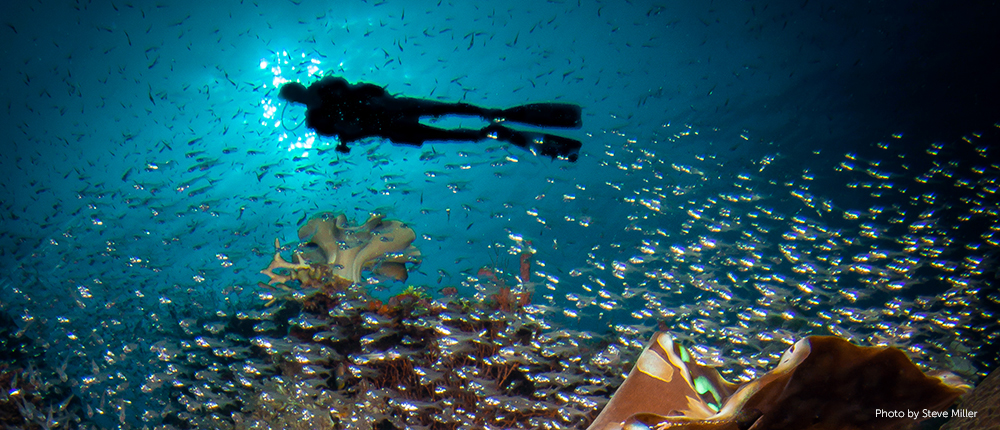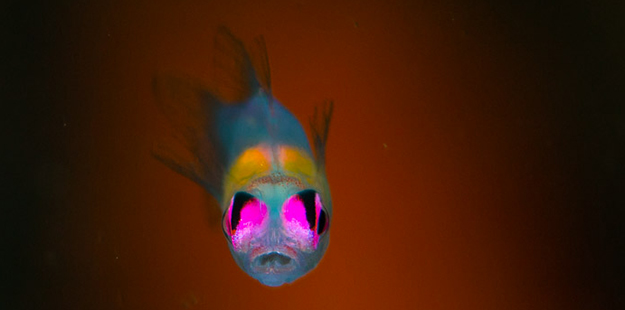Unsung Heroes
Wakatobi Resort’s dive guides are a photographer’s best asset
Each year, spectacular underwater images from the reefs of Wakatobi Resort appear in magazines, websites and photo presentations around the world. The photographers who create these images are justifiably lauded for their technical and artistic ability. But as many of these same shooters will be the first to attest, creating these portfolio prizes is often a team effort that includes the dive guide. This fact isn’t lost on veteran underwater photographer Wade Hughes.”Photo dive guides almost never appear in the picture credits, but they are the ones that can make the difference underwater,” he says. Wade has dived in some 30 countries and territories around the world, and has logged more than 250 dives at Wakatobi Resort alone. Wade recently wrote about some of his experiences working with one of our accomplished dive guides, Ketut Suardika. Following is Wade’s description, and a small sampling of the images he captured with Ketut.
Night moves
“It’s dark. Out of the gloom, Ketut’s slate suddenly materializes in front of my face, weakly illuminated in the few rays escaping between the fingers he’d curled over the lens of his dive light to protect my night vision. He’d written one question on it. ‘Bobtail?’ It was a classically understated question. What Ketut had found in the blackness—and was asking me if I wanted to photograph—was a juvenile bobtail squid, about a fifth of an inch long.
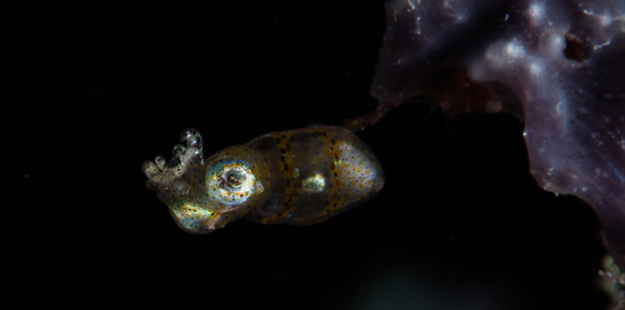
“Sometimes you just have to bang away and hope for the best: Ketut’s benighted, bobbing and weaving miniature squid.” Photo by Wade Hughes
“The miniscule squid was hunting around a hydroid, seemingly picking off pixel-sized crustaceans. It was flitting around, on a jutting corner of reef, and being swirled randomly back and forth, up and down, by the eddies of a current that, in open water, was almost too strong to swim against. That Ketut even found it in the first place was impressive enough. But then he turned and led me back through the darkness and the current, and somehow relocated it. There followed 20 minutes of that cramping exertion all too familiar to underwater macro photographers when the only thing not moving is the reef itself. Ketut sidled in like a living beanbag to help brace me against the current. With legs and fins pumping, the lens locked at its closest focus to stop it hunting, trying to hold the camera steady, neck craned, squinting hard through the viewfinder hoping to find the squid, I eventually resorted to just squeezing off a frame every time something—anything—blundered into focus.
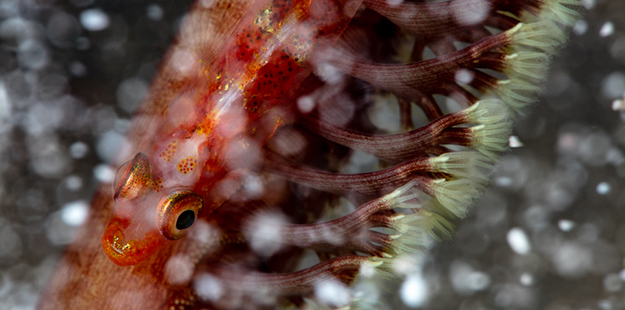
“About 10 minutes after Ketut had pointed him out I finally detected the millimetric movement of this perfectly camouflaged juvenile triplefin.” Photo by Wade Hughes
Tiny treasures
“Earlier that same day, I’d spent at least 10 minutes staring at a hand-sized patch of algae-fuzzed coral after Ketut had casually pointed into the center of it. With my face close enough to the coral to allow the prescription gauge reader lenses in my mask to do their job, I finally detected the millimetric movement of a perfectly camouflaged juvenile triplefin. Twenty minutes later, Ketut taps his tank with his reef pointer. Holding his magnifying glass in front of his face—and not taking his eyes from whatever he has found on the reef—he beckons to me with his free hand. Ketut is calling me over to tackle something with the unforgiving Nauticam SMC super-macro rig that even his laser-sharp eyes can see only with the aid of a magnifying glass. All this because I’d suggested that we might go look for super-macro subjects. You have to be careful what you wish for.
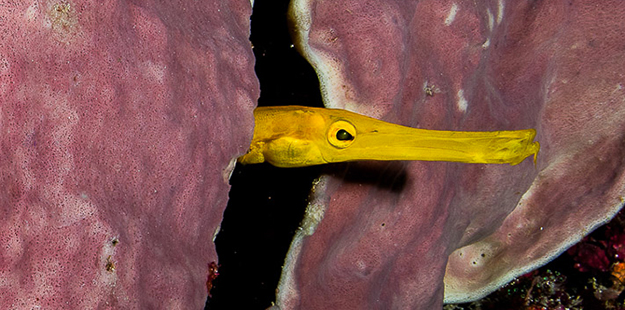
“The dark crack in the sponge offered an interesting pattern, so I framed it up and was about to wait in hope that something might eventually swim into an interesting position alongside it. This yellow trumpetfish apparently wondered what all the fuss was about!” Photo by Wade Hughes
“Ketut and the other members of the dive guide team at Wakatobi Dive Resort listen intently to their clients’ photographic aspirations. They take these aspirations seriously and work hard to help fulfill them. Over the course of more than 250 dives at Wakatobi Dive Resort, I have worked with Ketut, Shoko, Jono, Yusef, Kaz, Muji, and Marco Fierli, who is also Wakatobi Resort’s photo pro and a talented shooter in his own right. They all bring their own personalities and strengths to the relationship they forge with their clients. But they all have in common a deep local knowledge and a systematic approach to finding subjects, either from their clients’ wish lists, or opportunistically, based on their own searches and observations.
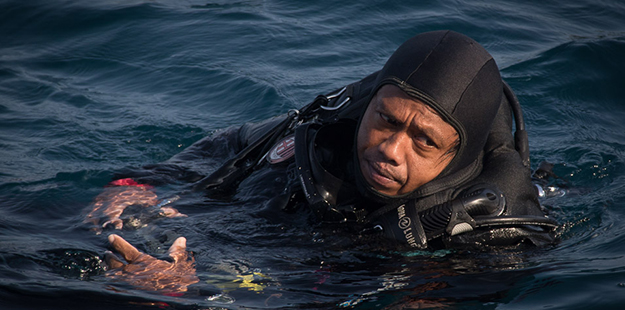
“Always thoughtful and focused, Ketut personifies the commitment of the Wakatobi photo dive guides. It is largely their experience and local knowledge that brings to light the diversity of marine life on these incredible reefs.” Photo by Robyn Hughes
“Taking the private guide option to tap into this catalogue of knowledge and experience does add to the cost of a Wakatobi visit, but you won’t regret it. On the regularly scheduled dive boats, you’ll still go to sea with the larger groups of divers, but you’ll be dropped on your own sections of reef, with your guide, to work undisturbed. Alternatively, you can work the House Reef with them at any time.
“The ultimate benefit comes though with the private guide/private boat option.”
“The ultimate benefit comes though with the private guide/private boat option. While this does increase your costs, it provides the most freedom and flexibility, and is well worth the investment. With the private boat you dive when you want, where you want, as frequently as you want. There’s no call to abandon a subject and move on, simply because others in the group have. There’s no-one else pressing you from behind for their turn to take a photograph. It’s the ideal way to really get to know an area in detail. It’s also ideal for building portfolios of specific species over extended periods of time. We use it for all these reasons.


